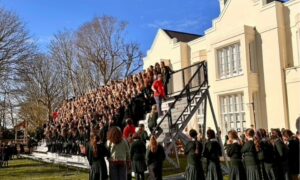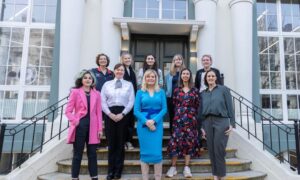Life behind a laptop is… how shall I put this? It’s interesting. For the time being at least, there is a novelty value. We are learning new tricks, mastering new skills. Don’t let anyone tell you it’s not varied. Within the rich tapestry of laptop life there are Zoom meetings, Microsoft Team meetings, staff meetings for over 50 attendees but with only three of them in the room – and don’t let anyone tell you it’s boring. There is plenty of entertainment to be had: those panicked mute/unmute microphone moments; the camera moments – colleagues caught dunking jammy-dodgers or pulling faces. As amusing as all this has been, however, the highlight of my week by far was the opportunity I had to ‘hangout’ (Google-style) with every Form in Year 7 to 10, at which point the laptop became a window on the teenage brain.
How are they all coping at home? What are they up to? As anticipated, the pupils of Brighton Girls are reacting in their unique and individual ways; their idiosyncrasies have, if anything, been enhanced. It was great to see. One has dyed her feet blue, another has dyed her hair pink; one has developed a passion for Formula 1, another has learnt how to crochet.
As well as checking how things were going with their home learning, my question to the girls was, “What have you discovered about yourself in the last two weeks, both as a learner and as a human being?” The answers were fascinating and different themes emerged for each year group. Year 9 make a particularly interesting case study. As any teacher will tell you, Year 9 is often the year of disaffection, the unfulfilling limbo state, a time for teenage angst to set in, for self-consciousness and self-doubt. But, by and large, the Year 9 girls I spoke to this week were incredibly chilled. Why? One had realised she expends a lot of mental energy thinking about other people: “I have realised I spend a lot of time thinking about what others are thinking, and making comparisons with how others are working”. Others admitted feeling more relaxed as there is no longer a need to put on a ‘game face’ – they can be themselves. They are feeling (in their own words) “thoughtful” and “interested” in the world around them.
The question I am asking myself is this: how can we take some of these positives and assimilate them into school life when the world returns to normal? We want girls to always be relaxed and to always be themselves. Should lessons start a little later? Should we allow time for a Joe Wicks-style workout after Form time each day (I now realise that Friday Fun time at the Prep School was ahead of its time). I’m also wondering how much of their home-learning selves the girls will bring back to the classroom. Will they care less about what people think because they just happy to have people around? Will the introverts find it hard to readjust to the hustle and bustle in the corridors? Will the blazer-haters now wear their blazers with pride or will they feel even more constrained?
I have, this week, launched an initiative that has been in my mind for some time, which is to establish a small research centre at Brighton Girls. The current coronavirus pandemic is affecting our girls in a variety of ways and I think there is a real opportunity for us to explore the impact. I have, therefore, invited staff throughout the school to engage in Action Research projects (through the Expansive Education Network and the Institute of Education) next academic year. The projects could be subject-specific or related to mental health or wellbeing, but all will explore an aspect of how girls learn; their response to the current situation; or how they assimilate new working habits when school life returns to normal. There have been some interesting suggestions already and I can’t wait to see what new insights we will gain.


